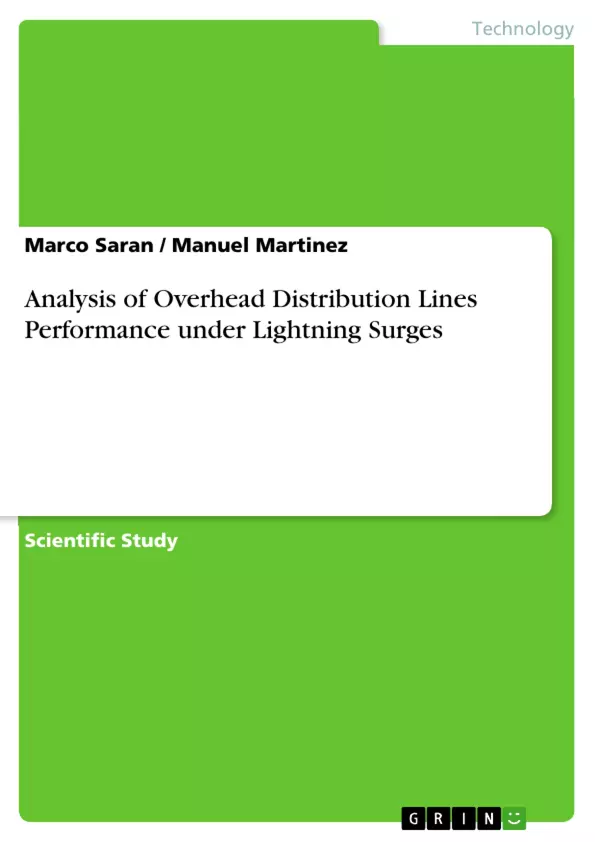The medium voltage system performance analysis of front lightning discharges is very dependent on its modeling. As the model approaches the reality, the more it becomes extremely complex and time expensive. As a result, it generally leads to the adoption of some sort of simplifications and approximations.
The present work aims at the study of a large variety of effects of the lightning discharges, its impacts and preponderant factors for analysis in different real systems, as far as searching for a balance between the model's approximation and the resultant errors. With this in mind, it uses models that are more precise, stochastic process simulations, electromagnetic transient simulations, real information from the networks and statistical analyses. Therefore, it is possible to establish the main intervention points for the improvement of the medium voltage overhead distribution system performance front lightning
discharges.
Frequently asked questions
What is the main topic discussed in this text?
The text discusses the effects of lightning discharges on medium voltage overhead distribution systems, focusing on simulations and performance analyses of these systems under lightning strikes.
What parameters are considered for lightning discharge simulations?
The simulations consider parameters such as lightning discharge current intensity, speed of the return stroke, point of impact, ground flash density (discharges/km²/year), and the use of the Monte Carlo Method to simulate many years of lightning discharges.
What are some simplifications made in the modeling process?
Simplifications include adopting a plain area without topography or elevation data, not automatically considering elevated structures like towers and trees (though they can be included manually), and using a single-phase modeling approach for faster analysis.
What is the Electro-Geometrical Model used for?
The Electro-Geometrical Model is used to determine the attractiveness area and whether a lightning discharge will strike a structure, the network, or the ground.
What are the two main cases considered for calculating peak overvoltage in the network?
The two cases are: direct interception of the network by the lightning discharge, and induced surges caused by lightning strikes near the network.
What is LIOV-EFEI code?
LIOV-EFEI is a code based on the LIOV (Lightning Induced Over-Voltage) code developed at the University of Bologna, adapted by the High Voltage Laboratory (LAT-EFEI) of the Federal University of Itajubá, Brazil, to calculate induced surges in distribution networks.
Which types of networks are simulated in performance simulation?
The simulations include rural networks, flat urban networks, and urban networks considering elevated structures.
How does the presence of elevated structures affect the performance of urban networks?
The presence of elevated structures, such as buildings and towers, tends to decrease the amount of lightning directly intercepting the network by providing a shielding effect.
What is the typical probability of direct interception in metropolitan regions?
Metropolitan regions, with a higher amount of high constructions, tend to have extremely low levels of direct interceptions by the network.
What role do surge arresters play in the distribution network?
Surge arresters dissipate the surge energy to prevent overvoltage's in the electrical circuits of the system such as transformers and insulators.
What was the purpose of performing electromagnetic transient simulations through ATP?
Electromagnetic transitory simulations through the ATP program were executed to detail and analyze the dynamics and distribution of the surge into the system and the response from the installed equipment.
What are some of the best practices for utilities regarding lightning protection?
Best practices include correctly specifying and maintaining the quality of surge arresters, raising the basic insulation level (BIL) of insulators, and ensuring that transformers have the highest possible BIL, as well as always using surge arrester unities in its terminals.
What was validated to determine the accuracy of simulations?
Real measurements of current intensities released by surge arresters were compared with simulated outcomes to validate the reliability of the model.
According to simulations, which network type experiences the greatest chance of outages due to lightning?
Overhead distribution systems in rural regions are more susceptible to faults and outages brought on by induced surges, according to simulation data.
- Quote paper
- Marco Saran (Author), Manuel Martinez (Author), 2009, Analysis of Overhead Distribution Lines Performance under Lightning Surges, Munich, GRIN Verlag, https://www.grin.com/document/338848



